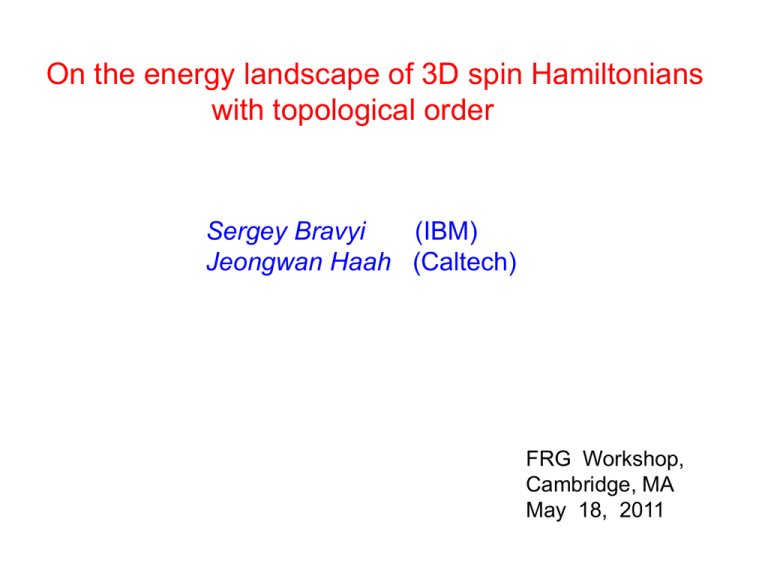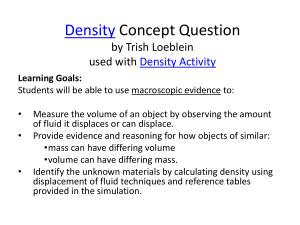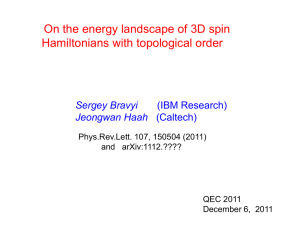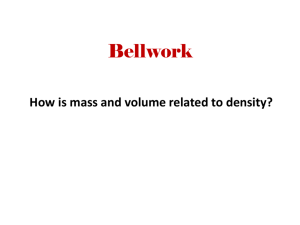Slides PPT
advertisement

On the energy landscape of 3D spin Hamiltonians with topological order Sergey Bravyi (IBM) Jeongwan Haah (Caltech) FRG Workshop, Cambridge, MA May 18, 2011 Outline • Classical and quantum self-correcting memory • No-go theorem for quantum self-correction in 2D • String-like logical operators • 3D spin Hamiltonian with conjectured self-correction • Renormalization group lower bound on the energy barrier magnetic field h Classical self-correcting memory: 2D Ising model L Stability region Tc T L H = ¡ J ¡ h P ( i ;j ) P j ¾j ¾i ¾j free energy Macroscopic energy barrier JL magnetization Stores a classical bit reliably when h=0 and T<Tc Poor quantum memory: ground states are locally distinguishable β=0.48 β =0.45 β =0.44 β =0.40 Lattice size L=256 Metropolis dynamics: • If a spin flip would decrease energy, flip it • Otherwise, flip it with probability Quantum memory Hamiltonians based on stabilizer codes 1. Qubits live at sites of a 2D or 3D lattice. O(1) qubits per site. 2. Stabilizers Ga live on cubes. O(1) stabilizers per cube. 3. Stabilizers Ga are products of I, X, Y, and Z 4. Ground states are +1 eigenvectors of all stabilizers. Use quantum system to store quantum bits Storage Interaction with a thermal bath kept at some fixed temperature over time t. Decoding Encoding Use quantum system to store classical bits Error correction: (1) Measure eigenvalue of every stabilizer. It reveals error syndrome S. (2) Guess the most likely equivalence class of errors consistent with S. (3) Return the system to the ground state. Only need macroscopic energy barrier for logical X operators. Need macroscopic energy barrier for logical X, Y, Z operators. Storage phase Analogues of spin flips: Pauli operators X, Y, Z Stabilizer Hamiltonians: Pauli operators map eigenvectors to eigenvectors. Metropolis dynamics is well-defined. Necessary conditions for quantum self-correction: Bacon, quant-ph/0506023 S.B. and Terhal, arXiv:0810.1983 Pastawski et al, arXiv:0911.3843 1. Ground states are locally indistinguishable (TQO) An operator acting on a `microscopic’ subsystem has the same expectation value on all ground states. 2. Macroscopic energy barrier Any sequence of single-qubit errors X,Y,Z mapping one ground state to another must cross an energy barrier. Infinite barrier in the thermodynamic limit. h h= 0 Tc T Phase Diagram of Classical Ising model in D > 1 dimension. Stores a classical bit reliably when h=0 and T<Tc Conjectured & proved phase diagrams for toric code Hamiltonians* h h D=2 T Degenerate ground state stores a qubit reliably at T=0, even for nonzero h. Unstable for T>0. h D=3 Tc D =4 T Tc T Stores a qubit at Stores a quantumT=0. For T>0, encoded qubit even stores a quantumat nonzero T and h. encoded classical *Alicki, Fannes, Horodecki, bit, probably even 0811.0033… S.B., Hastings, Michalakis, when h is nonzero 1001.0344 Kitaev 1997: toric code models Spins ½ (qubits) live on links 0 1 1 0 1 0 0 -1 Stabilizers Star operators: Plaquette operators: Logical string-like operators Star operators: X X X X X X String Applying a string-like operator to a ground state creates a pair of topologically non-trivial excitations at the end-points of a string. Contractible closed strings = product of plaquette operators. Similar string-like operators of Z-type exist on the dual lattice. Logical-Z operator Logical-X operator X Z X X X X X Z Z Z Z and commute with all stabilizers. and have non-trivial action on the ground subspace Logical string-like operators X energy barrier is O(1) X X X X X X X X X X X X X X X X Sequence of local X-errors implementing logical-X operator. At each step at most 2 excitations are present. Energy barrier = 4 regardless of the lattice size. 2D and 3D Hamiltonians with TQO: negative results Any 2D stabilizer Hamiltonian has logical string-like operators. No-go result for quantum self-correction. Bravyi, Terhal 2008, Bravyi, Terhal, Poulin 2009, Kay, Colbeck 2008, Haah, Preskill 2011 Logical string-like operators were found for all 3D stabilizer Hamiltonians studied in the literature. Chamon 2005, Bravyi, Terhal, Leemhuis 2010, Hamma, Zanardi, Wen 2005, Castelnovo, Chamon 2007, Bombin, Martin-Delgado 2007. Recent breakthrough: 3D model which provably has no logical string-like operators (Jeongwan Haah arXiv:1101.1962 ) Z2 Z1 Z1 Z 1Z 2 Z1 X1 X1X2 X2 X1 Z2 Z2 X2 X2 X1 Qubits live at sites of 3D cubic lattice (2 qubits per site) Stabilizers live at cubes (2 generators per cube) Topological quantum order Not quite realistic: periodic boundary conditions for all coordinates Main question for this talk: Suppose a stabilizer Hamiltonian has TQO but does not have logical string-like operators. What can we say about its energy barrier? First need to define rigorously TQO and string-like logical operators… Definition: a cluster of excitations S is called neutral iff S can be created from the vacuum by acting on a finite number of qubits. Otherwise S is called charged. X X Neutral cluster X X X X X X X Charged cluster Topological Quantum Order: 1. Ground states cannot be distinguished on cubes of linear size Lb for some b>0. 2. Let S be a neutral cluster of excitations. Let C(S) be the smallest cube that contains S. Then S can be created from the vacuum by acting only on qubits of C(S). Logical string segments (Haah arXiv:1101.1962) X X Z X Z Y Y Z Y Z Z Z X X Y Y Y Y Z X Y X X Z X Y Y - Pauli operator e e e e e e e Applying P to the vacuum creates excitations only inside P is a logical string segment. - anchors of the string A logical string segment is trivial iff the cluster of excitations inside each anchor region is neutral. Trivial logical string segments are ``fake strings”: e e e e e e e e e e e e e e for all ground states e e e e e e e Linear size of the anchors: w, Distance between anchors: R12 Aspect ratio: Theorem Consider any stabilizer code Hamiltonian with TQO. Local stabilizers on a D-dimensional lattice with linear size L. Suppose there exists a constant α such that any logical string segment with the aspect ratio greater than α is trivial. Then the energy barrier for any logical operator is at least The constant c depends only on α and spatial dimension D. Haah’s code: α=15. The lower bound is tight up to a constant. Lower bound on the energy barrier: renormalization group approach Absence of long logical string segments = `no-strings rule’ Absence of long logical string segments = `no-strings rule’ No-strings rule implies that charged isolated clusters of excitations cannot be moved too far by local errors: e Absence of long logical string segments = `no-strings rule’ No-strings rule implies that charged isolated clusters of excitations cannot be moved too far by local errors: e e e e R αR Dynamics of neutral isolated clusters is irrelevant as long as such clusters remain isolated. The no-strings rule is scale-invariant. Use RG approach to analyze the dynamics of excitations. Sparse and dense syndromes Syndrome is a cluster of excitations created by some error. Excitations live on elementary cubes of the lattice. Define a unit of length at a level-p of RG: Use distance. Elementary cubes have diameter =1. Definition: a syndrome S is called sparse at level p if the subset of cubes occupied by S can be partitioned into disjoint union of clusters such that 1. Each cluster has diameter at most r(p), 2. Any pair of clusters combined together has diameter greater than r(p+1) Renormalization group method RG level A sequence of local errors implementing a logical operator P defines level-0 syndrome history: time 0 = vacuum, S = sparse syndromes, D= dense syndromes Level-0 syndrome history. Consecutive sydnromes are related by single-qubit errors. Some syndromes are sparse (S), some syndromes are dense (D). RG level Renormalization group method time 0 = vacuum, S = sparse syndromes, D= dense syndromes Level-1 syndrome history includes only dense syndromes at level-0. Level-1 errors connect consecutive syndromes at level-0. RG level Renormalization group method time 0 = vacuum, S = sparse syndromes, D= dense syndromes Level-1 syndrome history includes only dense syndromes at level-0. Level-1 errors connect consecutive syndromes at level-0. Use level-1 sparsity to label level-1 syndromes as sparse and dense. RG level Renormalization group method time 0 = vacuum, S = sparse states, D= dense states Level-2 syndrome history includes only dense syndromes at level-1. Level-2 errors connect consecutive syndromes at level-1. RG level Renormalization group method time 0 = vacuum, S = sparse states, D= dense states Level-2 syndrome history includes only dense excited syndromes at level-1. Level-2 errors connect consecutive syndromes at level-1. Use level-2 sparsity to label level-2 syndromes as sparse and dense. RG level Renormalization group method time 0 = vacuum, S = sparse syndromes, D= dense syndromes At the highest RG level the syndrome history has no intermediate syndromes. A single error at the level pmax implements a logical operator Cluster Merging Lemma. Suppose a syndrome S is dense at all levels 0,…,p. Then S contains at least p+2 excitations. Example: suppose non-zero S is dense at levels 0,1,2 e r(1) r(2) r(3) e e e RG level Localization of level-p errors time No-strings rule can be used to `localize’ level-p errors by multiplying them by stabilizers. Localized level-p errors connecting syndromes S and S’ act on r(p)-neighborhood of S and S’. Localization of level-p errors Localization Lemma Let S and S’ be a consecutive pair of level-p syndromes. Let E be the product of all level-0 errors between S and S’. Let m be the maximum number of excitations in the syndrome history. Suppose that p is sufficiently small: Then E is equivalent modulo stabilizers to some error supported only on r(p)-neighborhood of S U S’. A single error E at the highest RG level implements a logical operator. The smallness of p condition in Localization Lemma must be violated at this level. Otherwise the lemma says that E is a stabilizer. Therefore We can assume that m=O(log L), otherwise we are done. Therefore The history must contain a syndrome which is dense at all levels below pmax-1. Cluster Merging Lemma implies that such syndrome has at least pmax defects QED Logical operators of the Haah’s code with the logarithmic energy barrier Z2 Z1 Z2 Z1 e Z2 e Z 1Z 2 Z1 Stabilizer of Z-type e e Excitations created by a single X1 error located in the center of the cube (dual lattice) This cluster of excitations is called level-0 pyramid e X X X e X e X X e X X Level-p pyramid X X X X X X X X Corresponding error (level p=2) Suppose the lattice size is L=2p for some integer p. Then level-p pyramid = vacuum. The corresponding error is a logical operator of weight L2 Energy barrier for pyramid errors 16 Optimal error path creating level-p pyramid = concatenation of four optimal error paths creating level-(p-1) pyramids 13 14 4 1 8 2 5 Energy barrier: 6 Becomes a logical operator for p=log2(L) 15 12 3 9 10 7 11 Conclusions Quantum self-correction requires two properties: - ground states are locally indistinguishable (TQO) - macroscopic energy barrier All stabilizers Hamiltonians in 2D have string-like logical operators. The energy barrier does not grow with lattice size. Some stabilizer Hamiltonians in 3D have no string-like logical operators. Their energy barrier grows logarithmically with the lattice size.








